The Best Gym Trainers
Set yourself up for success with these top gym shoes for every type of workout
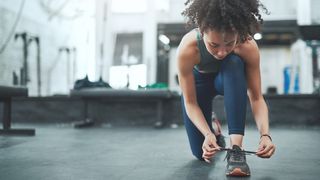
After shelling out for a gym membership, you’d be forgiven for hoping you could skip the purchase of a new pair of workout shoes. And you can! As long as you take it easy, any old trainers will do, but if you’re looking to make the most of your gym membership then investing in a pair of the best gym trainers could pay off. The right shoe can make a world of difference to your gym training.
The best starting point is to figure out what type of workout you plan to do, because that can steer you towards the most appropriate features.
There are plenty of do-it-all cross-trainers, but each model will prioritise features that lean towards a certain discipline, which we’ll indicate in our recommendations below. The best CrossFit shoes have to combine enough cushioning to handle box jumps and short runs with the stability needed to handle technical lifts, as well as being durable.
The best weightlifting shoes include additional heel support and a stable base, which will set you up for success when lifting, especially squatting. They will also have a significant drop or offset (the difference between the height of the heel and the height at the front of the shoes), which helps mobility.
Another feature to watch out for is extra grip on the edges of the sole to aid quick lateral movements. This is helpful if you’re attempting speed and agility training.
One word of warning: the best running shoes aren’t a great option for the gym unless you plan on doing exclusively treadmill workouts. The extra cushioning makes for an unstable base when lifting weights and—since runners only move forwards—running shoes tend to lack support for quick lateral movements, making it easier to turn an ankle. Fear not if you are a runner who’s planning to spend more time in the gym and want one shoe to do it all—we have a great pick from On that will suit you.
We’ve pulled together our picks for the best gym trainers for every need. Find the right pair for you and go get ’em, tiger.
Best Gym Trainers
You can trust Coach
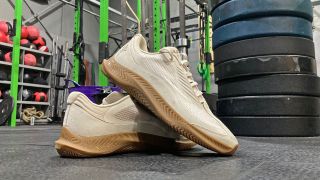
Specifications
Reasons to buy
Reasons to avoid
The fledgling brand’s first shoe is a home run, delivering a level of comfort I rarely associate with a gym shoe, along with its solid all-round performance. The shoe looks good, too. To the point where I’ll happily wear mine for meals out, going around town and any number of non-gym activities.
The shoe was designed with CrossFit in mind, featuring a Swell Foam midsole that feels light and responsive during explosive exercises like burpees. However, unlike a running shoe there’s no thick foam stack under the heel that can make a shoe feel clunky during moves like box jumps.
A TPU stability cage that wraps around the shoe provides extra stability during lifting and lateral movements. My only qualm was that I would’ve liked to see more stability around, and firmness in, the heel for exercises like heavy squats. But, this aside, if you’re looking for a gym shoe that looks great, feels great and offers an impressive, versatile performance, this is the one for you.
Read more in my R.A.D One review
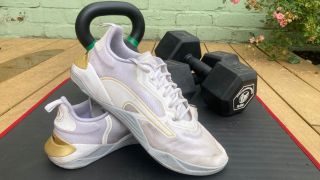
Specifications
Reasons to buy
Reasons to avoid
The best gym shoes don’t usually come cheap. The Puma Fuse 2.0 does, however, with a $100/£90 RRP and some considerable discounts on offer.
But can such affordable fitness footwear hold a candle to its more costly counterparts? In my thorough tests, I found that the Puma Fuse 2.0 can.
The shoe has a natural fit that I found incredibly comfortable straight out the box. My first session wearing it consisted of a couple of metcons made up of squats, running intervals and dumbbell clean and jerks, among other moves, and it kept my feet feeling fresh with no sign of rubbing.
The Fuse 2.0 has enough cushioning to soften the blow of high-impact exercises, as well as a wide forefoot which allowed me to spread my toes for balance while lifting weights.
During complex lifts like the clean, the heel didn’t feel as stable as those on the likes of the Nike Metcon 9, and there was some compression in the midsole when squatting heavier weights. I also saw a considerable amount of wear to the inner lining of the heel after a month of use.
Overall, this is an impressive second outing for Puma in the functional fitness footwear arena, particularly when you consider the price. It’s good (if not great) for lifting thanks to the wide forefoot, and feels light and comfortable for circuit-style workouts or HIIT sessions.
Read more in my Puma Fuse 2.0 review

3. On Cloud X 3
Our expert review:
Specifications
Reasons to buy
Reasons to avoid
For every other shoe on this list, I’d caveat my recommendation with the fact that you shouldn’t run more than 3km in them. Though they’re all designed for versatility in a gym environment, the stability needed for lifting weights comes at the expense of cushioning for longer runs—but there’s one exception.
The On Cloud X 3 is the Swiss brand’s premiere training shoe and it holds up impressively well during running and gym sessions. In a week, I wore it for a steady 10K, a squat session, 800m intervals and a weighted circuit workout, and while it was clearly stronger in certain areas (the intervals) it didn’t disgrace itself in any department.
It’s firmer and less cushioned than most running shoes, giving it a faster, more reactive feel for short to mid-distance efforts (up to 10km-15km). This makes it well-suited to plyometric exercises that require you to be light on your feet too; I found it handled the box jumps and burpees in my circuit workout like a dream. The shoe has a flared midsole around the heel, giving it more stability for leg exercises than other runners. It’s this versatility that makes the On Cloud X 3 one of the first items in my bag when I go on vacation.
The only areas I’d swerve with this shoe are heavy strength-training days and certain CrossFit workouts. During my squat session, I found there was some compression under my heel as I worked up to heavier weights, and I didn’t feel I could generate power as efficiently as a result. And the upper, while delightfully lightweight for running and fleet-footed moves, feels too fragile for the rigors of exercises like rope climbs and wall walks.
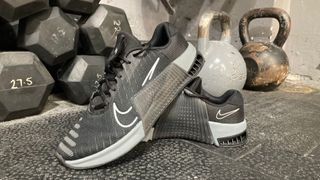
4. Nike Metcon 9
Our expert review:
Specifications
Reasons to buy
Reasons to avoid
If you want to know whether this shoe is right for you, you need to consider two questions.
Does your training revolve around lifting heavy weights? And, do you have narrow feet?
The answers in support of the Metcon 9 are yes and no, respectively. This shoe is stable thanks to its wide base, supportive midfoot and the enlarged Hyperlift plate in the heel, making it an excellent lifting partner. The security and power transfer I experienced when squatting was the best of any shoe on this list.
However, as someone with narrow feet I found the shoe didn’t lock down my heel effectively, leading to unwanted movement when I was using them for running or rowing during a CrossFit workout. I’ve spoken to other owners and this issue isn’t universal, but I would recommend trying a pair on before you buy them.
I also found the chunky profile, rigid midfoot and firm heel—while great for lifting—felt clunky when I tried to do a HIIT-style session that required springiness and speed. But for stability, shifting heavy weights and general strength work this shoe was unmatched. If you’re someone who loves leg day, this may well be the shoe for you.
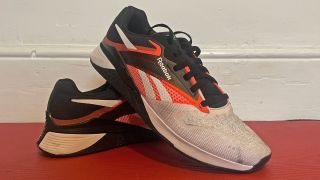
Specifications
Reasons to buy
Reasons to avoid
This is the 14th generation of the Nano, and it’s better than ever. Wearing the X4 for a fortnight, I found the latest incarnation of Reebok’s “official shoe of fitness” boasts more support, stability and comfort than any before it. This is an excellent all-round gym shoe.
The standout feature is the Lift and Run chassis; tech in the heel that expands to a dome to cushion high-impact exercises, then compresses under load for firm foundations when lifting heavy. This chassis made its debut in the X3 and impressed me then, with its only flaw being a lack of stability during lateral movements and landings while doing the likes of box jumps and Olympic weightlifting.
This isn’t a problem in the X4, which benefits from a revamped TPU heel clip designed to support multidirectional movement—something it did to great effect, with my feet feeling secure when landing everything from skaters to snatches. The redesigned Flexweave mesh upper feels robust, with ventilation zones to keep my feet cool and enough forefoot room for me to spread my toes for balance. On top of this, added heel padding provides a comfortable, locked-in fit straight out the box.
Read more in my Reebok Nano X4 review
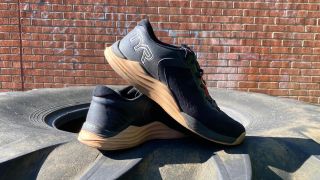
Specifications
Reasons to buy
Reasons to avoid
Swimming brand TYR made a splash with its first foray into the world of gym sneakers (and more specifically, CrossFit shoes) in 2022. Not only did it sign top CrossFit athletes like Pat Vellner and Annie Thorisdottir, but it also delivered a barnstorming debut shoe in the shape of the CXT-1.
The website says it has a “patent pending stability platform” around the heel—how mysterious. But whatever TYR has done, it should continue to do. The shoe offers a fantastically stable base for heavy leg exercises like squats and deadlifts, as well as more dynamic moves like Olympic lifts.
The breathable upper kept my feet cool and comfortable during even the sweatiest workouts, while the Surge NRG foam in the midsole felt supportive during high-impact exercises and short runs (although you’ll want a dedicated running shoe for distances over 2km).
Rubber guards rising around the toe, midfoot and heel also add to the CXT-1’s robustness, although I did find some wear to the heel lining after not much more than a month of use.
The fit is on the narrower side, which suited my feet, although prospective wearers with wider feet might want to consider other options like the Nike Metcon 9 or Inov-8 F-Lite G300.
Minor criticisms aside, this is an excellent gym shoe and it’s now my go-to for daily CrossFit training, whether I’m lifting, doing circuit-style workouts or anything else. So if you’re looking for an all-rounder, I can’t recommend the TYR CXT-1 enough.
Read more in my TYR CXT-1 review
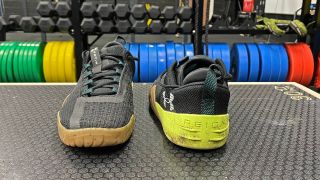
Specifications
Reasons to buy
Reasons to avoid
The Reign 6 will be perfect for some gym-goers, while others should steer clear. I’m going to describe these two camps so you can decide whether this shoe is for you.
You should avoid this shoe if you’re looking for footwear to see you through a fair amount of running—outdoor, treadmill, mid-circuit intervals or otherwise. It has a thin outsole, with all cushioning coming from a dual-density insole. This is firmer in the heel and softer in the toe, but I found neither area provided much support while running a series of 400m intervals.
Instead, the flexible shoe gave an almost barefoot feel and I felt the surface and textures of the Tarmac I was running on. This isn’t something I want for longer runs, but I liked it for lifting and workouts. That brings me to the second group.
If your time in the gym is dominated by lifting weights, exercise classes, HIIT workouts or a combination of them, the Reign 6 is a really solid performer. It offers great grip and impressive ground feel, which helped me generate power through the floor effectively during heavy squats and deadlifts. The shape of the shoe allowed me to spread my toes for balance, and the raised rubbed sidewall offered extra lateral support for HIIT staples like lateral burpees-over-barbell and skaters.
Read more in my Under Armour Reign 6 review
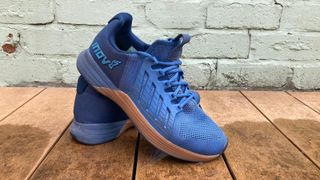
Specifications
Reasons to buy
Reasons to avoid
If you’re actively looking forward to your next leg day, you’re probably in the minority. You’re also going to love the Inov-8 F-Lite G 300.
It has more in common with a weightlifting shoe than most gym sneakers, featuring a wide forefoot as part of a flat, ergonomic, graphene-enforced outsole. Inov-8 also uses graphene as part of its Powerheel technology, designed to provide more support during heavy lifts.
The result, I discovered, is a comfortable shoe that offers excellent grip, stability and balance, making it a dream to squat in.
It’s not a one-trick pony though. The mesh upper is light and breathable—the whole shoe weighs in at a mere 300g (hence the name). There is also a decent stack of foam in the midsole that did not compress under heavy deadlifts and yet provided enough bounce to keep me comfortable through mid-circuit running intervals.
The only area in which I found it didn’t live up to the highest standards was dynamic exercises like HIIT sessions. The shoe, despite being light, felt clunkier than other gym sneakers I’ve tried on account of its larger upper and midsole stack. This took a bit of getting used to for moves like burpees and box jumps, and I still prefer my TYRs or Nike Metcons for any high-intensity training. I also found the fit quite wide, leading to a bit of movement around the heel during plyometric exercises. My feet are on the narrower side, though, and according to other wearers this issue isn’t universal.
Read more in my Inov-8 F-Lite G 300 review
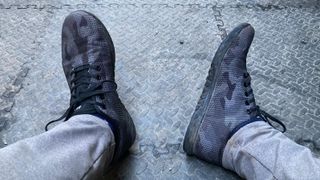
Specifications
Reasons to buy
Reasons to avoid
It’s little surprise that a dedicated CrossFit shoe is tough, but this one is tougher than most. I tested them for five months, putting in three 90-minute sessions a week, and the only sign of wear is a faint crease across the toe box. The upper is made from a single piece of durable material that’s designed to prevent abrasion from equipment—in rope climbs, for example—and guard plates are positioned around the base of the shoe to increase the overall protection.
It makes this shoe a great choice if you plan on going hard at the gym, and the firm sole lends itself to an intense style of training too, allowing for effective transfer of power through the shoe during HIIT workouts and barbell lifts. The flipside is that the lack of cushioning can make running especially hard on your legs.
The designs also cater to a range of tastes, with block colours and eye-catching prints offered in different combinations on the sole and upper—from all black to all-over floral print.
Read more in my Nobull Trainer review
Get the Coach Newsletter
Sign up for workout ideas, training advice, reviews of the latest gear and more.
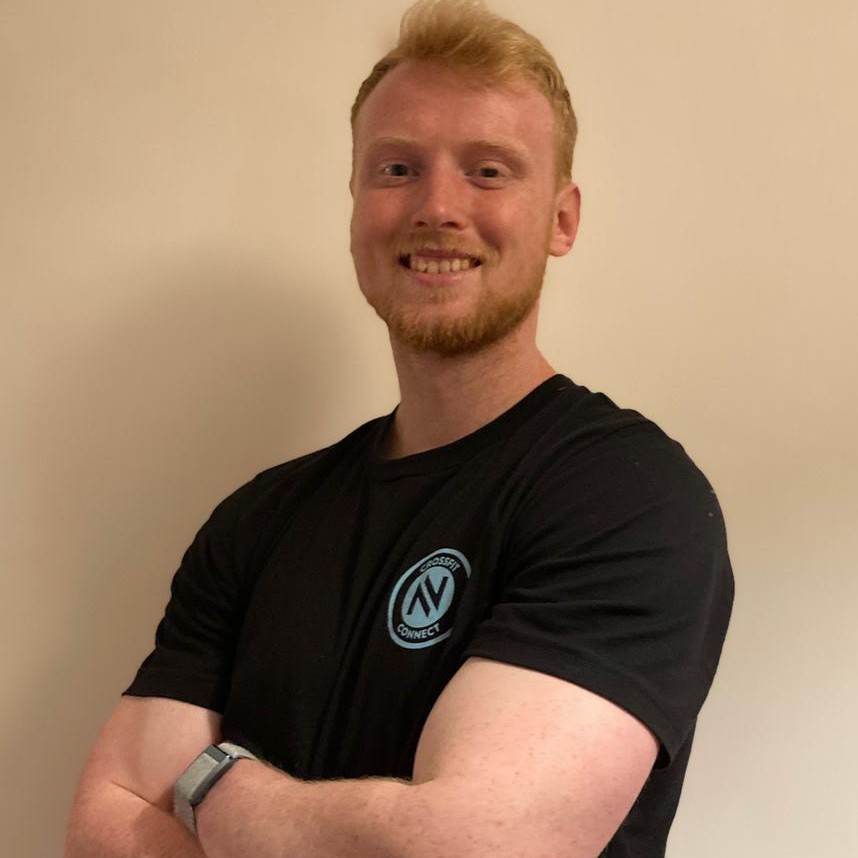
Harry covers news, reviews and features for Coach, Fit&Well and Live Science. With over a decade of training experience, he has tried everything from powerlifting to gymnastics, cardio to CrossFit, all in a bid to find fun ways of building a healthy, functional body.
- Jonathan ShannonEditor
